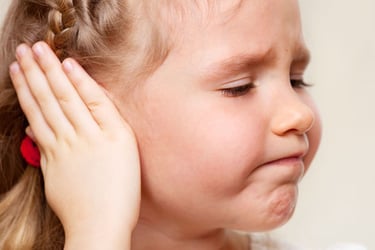Acute Otitis Media


Acute otitis media (AOM) refers to an infection of the middle ear, often characterized by ear pain, fever, and sometimes fluid buildup behind the eardrum. It is a common condition in children. Here are some important points to consider regarding AOM in children:
1.Symptoms: Children with AOM may exhibit symptoms such as ear pain or pulling at the ears, fever, irritability, decreased appetite, trouble sleeping, fluid draining from the ear (in some cases), and hearing difficulties. Young children may have difficulty expressing their discomfort and may display general fussiness or crying.
2.Causes: AOM is usually caused by bacterial infection, commonly following a viral upper respiratory infection. The bacteria most often involved are Streptococcus pneumoniae, Haemophilus influenzae, and Moraxella catarrhalis.
3.Diagnosis: A healthcare professional, typically a pediatrician, can diagnose AOM by examining the child's ear using an otoscope. The presence of a red, bulging eardrum, along with other symptoms, helps confirm the diagnosis. In some cases, further evaluation, such as a tympanometry test or a culture of the ear fluid, may be recommended.
4.Treatment: Treatment for AOM often involves a combination of pain relief and antibiotics. Pain relief can be achieved through over-the-counter pain medications like acetaminophen or ibuprofen, as recommended by the healthcare professional. Antibiotics may be prescribed if the child is under 6 months of age, has severe symptoms, or is at increased risk for complications. For older children, the healthcare professional may adopt a "wait-and-see" approach, monitoring symptoms for 48 to 72 hours before deciding on antibiotic treatment.
5.Follow-up: It is important to follow up with the healthcare professional if symptoms worsen or fail to improve after starting antibiotics. This allows for reassessment and consideration of alternative treatment options.
6.Prevention: Reducing the risk of AOM can be achieved by promoting good hygiene practices, including regular handwashing, avoiding exposure to secondhand smoke, and ensuring up-to-date vaccinations, such as the pneumococcal conjugate vaccine and the influenza vaccine.
It is essential to consult with a healthcare professional for an accurate diagnosis and appropriate treatment of AOM in children. They can provide personalized guidance based on the child's age, medical history, and the severity of symptoms.
Emre Göçer
